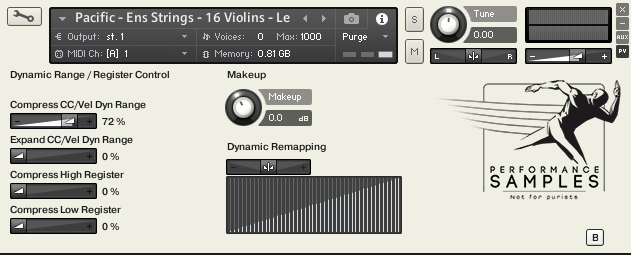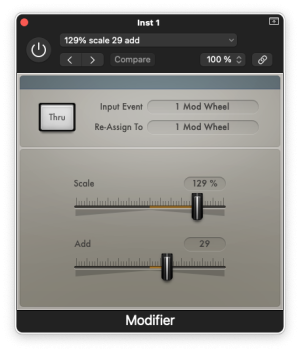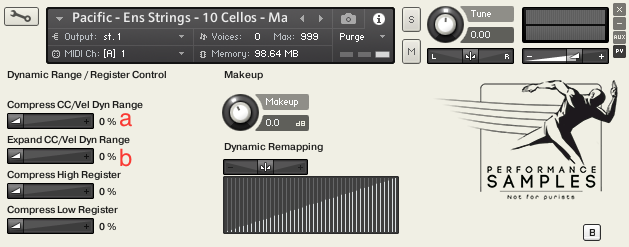Vik
Vi-k
This is about ways to make libraries sound more realistic, achieve an easier workflow, and, if desired, avoid potential side effects of our faders moving too much into the most intense dynamic levels (example: portamento transition may pop up, more than you want them to). It's also about how not only using CC11/expression, but also CC 1/Modulation can cause artifacts.
Usually CC1 controls xfading between dynamic layers, and CC11 alters the volume. This leads to the false idea that when using only CC1, everything works just like with real instruments, but in a library with 4 dynamic layers, there are only 4 out of 127 CC1 Values which offers 'non-faded' levels. (Some of this has already been discussed in one of the Pacific threads.)
This is important to be aware at the top and bottom of the dynamic range. In the lowest range, you may find that Dynamic Layer 1 (the most quiet) isn't placed at CC value 1, but maybe at 22.
You may see that there isn't any xfading at the highest dynamic range either – after all, there's no layer to xfade into. Instead there's a boosting of the volume of Layer 4, to make it even louder. This may eg. begin around CC1 levels around 100-105. This can be useful, but comes with a side effect – it's easy to accidentally bump into the area which simply boosts the volume instead of xfading into another layer.
Another side effect of all this is that if the 20 lowest and 20 highest values are reserved for volume reduction or boost, your total dynamic range spans over (127-40) 87 values.
If we round that off to 88 for simplicty each of the four layers have a span of average only (88/4) 22 values. This means that your 10mm fader too short for detailed control.This can be addressed by using a MIDI plugin on the track, which scales the CC values by, say, 60% and in addition adds a 'CC makeup', adding eg 20 to all incoming values.
On top of all this, some people also use CC11 at the same time as they use CC1, which creates more trouble: all the volume changes become twice as dramatic, since volume changes now happens both with CC11 and with CC1 (remember that only 4 out of the 127 values contain a sample with non-altered or non-faded level). Result: controlling dynamics feels bumpy, the changes are too dramatic.
Before I continue: presets which adds some down-fading at the bottom and upfading at the top can definitely be useful as a 'lazy but not so realistic solution'. But why not have more options to choose between?
Performance Samples Pacific (and Vista) offers this solution (I use Pacific as an example since this may soon become my go-to library):

Here you can both compress and expand the dynamic range. There's also a Makeup value, but since the calues is defined in decibel, I suspect that this may alter the audio signal (haven't checked that yet).
• Whether this is true or not, it would be great to have a 'CC value offset' here. By setting this to eg. 22, you'd never risk altering your dynamic levels down to where it sounds 'faded' or 'sounding MIDI'.
The values about 'register' refers to pitch register.
Here's an example of a MIDI plugin (from Logic):

This one offers an Add value, aka the CC Makeup idea I mentioned above, so maybe using the Modifer to set the add value for the CCs combined with the Compress options in Pacific would be useful – but it's a little more complicated than that.
First of all: how can we figure out exactly what the ideal values would be when using these tools? In Logic's so called Environment, there's a way to find some useful answers by setting up this chain of objects. The image below shows that (with the number I've entered into the Real Time Transformer), placing my external fader at the top (127) will send a value of 91 into the sequences input.

This is useful for several reasons – for instance if one wants to avoid most of the most intense portamento transitions. t also helps with generally avoiding unwanted boosting at the top (dynamic) levels.
But the solution is cumbersome, so the MIDI plugin is more tempting. However, when using the MIDI plugin, we can't control and monitor exactly what happens, because the signal are still stored at value CC1/127 even if what we hear is CC1/91.
• For this reason it would be great if Pacific and other libraries came with a way to shows us the incoming (coming into the plugin, not into the sequences) CC values, either as a simple number, a moving slider, both, or something else. Some libraries offer that already.
• In order to avoid all kinds of cumbersomeness, it would also be great if Pacific and all other libraries came with a way to store settings for compressing/expanding and add/makeup, with names – or even come with a set of useful presets.
• Meanwhile, it may be smart to manually avoid the lowermost and uppermost levels of your Modhweel or external controller.
For the records, this isn't meant as a criticism against Pacific, of course – after all, this is one of the few libraries which come with a way to alter dynamic range behavior.
Usually CC1 controls xfading between dynamic layers, and CC11 alters the volume. This leads to the false idea that when using only CC1, everything works just like with real instruments, but in a library with 4 dynamic layers, there are only 4 out of 127 CC1 Values which offers 'non-faded' levels. (Some of this has already been discussed in one of the Pacific threads.)
This is important to be aware at the top and bottom of the dynamic range. In the lowest range, you may find that Dynamic Layer 1 (the most quiet) isn't placed at CC value 1, but maybe at 22.
You may see that there isn't any xfading at the highest dynamic range either – after all, there's no layer to xfade into. Instead there's a boosting of the volume of Layer 4, to make it even louder. This may eg. begin around CC1 levels around 100-105. This can be useful, but comes with a side effect – it's easy to accidentally bump into the area which simply boosts the volume instead of xfading into another layer.
Another side effect of all this is that if the 20 lowest and 20 highest values are reserved for volume reduction or boost, your total dynamic range spans over (127-40) 87 values.
If we round that off to 88 for simplicty each of the four layers have a span of average only (88/4) 22 values. This means that your 10mm fader too short for detailed control.This can be addressed by using a MIDI plugin on the track, which scales the CC values by, say, 60% and in addition adds a 'CC makeup', adding eg 20 to all incoming values.
On top of all this, some people also use CC11 at the same time as they use CC1, which creates more trouble: all the volume changes become twice as dramatic, since volume changes now happens both with CC11 and with CC1 (remember that only 4 out of the 127 values contain a sample with non-altered or non-faded level). Result: controlling dynamics feels bumpy, the changes are too dramatic.
Before I continue: presets which adds some down-fading at the bottom and upfading at the top can definitely be useful as a 'lazy but not so realistic solution'. But why not have more options to choose between?
Performance Samples Pacific (and Vista) offers this solution (I use Pacific as an example since this may soon become my go-to library):

Here you can both compress and expand the dynamic range. There's also a Makeup value, but since the calues is defined in decibel, I suspect that this may alter the audio signal (haven't checked that yet).
• Whether this is true or not, it would be great to have a 'CC value offset' here. By setting this to eg. 22, you'd never risk altering your dynamic levels down to where it sounds 'faded' or 'sounding MIDI'.
The values about 'register' refers to pitch register.
Here's an example of a MIDI plugin (from Logic):

This one offers an Add value, aka the CC Makeup idea I mentioned above, so maybe using the Modifer to set the add value for the CCs combined with the Compress options in Pacific would be useful – but it's a little more complicated than that.
First of all: how can we figure out exactly what the ideal values would be when using these tools? In Logic's so called Environment, there's a way to find some useful answers by setting up this chain of objects. The image below shows that (with the number I've entered into the Real Time Transformer), placing my external fader at the top (127) will send a value of 91 into the sequences input.

This is useful for several reasons – for instance if one wants to avoid most of the most intense portamento transitions. t also helps with generally avoiding unwanted boosting at the top (dynamic) levels.
But the solution is cumbersome, so the MIDI plugin is more tempting. However, when using the MIDI plugin, we can't control and monitor exactly what happens, because the signal are still stored at value CC1/127 even if what we hear is CC1/91.
• For this reason it would be great if Pacific and other libraries came with a way to shows us the incoming (coming into the plugin, not into the sequences) CC values, either as a simple number, a moving slider, both, or something else. Some libraries offer that already.
• In order to avoid all kinds of cumbersomeness, it would also be great if Pacific and all other libraries came with a way to store settings for compressing/expanding and add/makeup, with names – or even come with a set of useful presets.
• Meanwhile, it may be smart to manually avoid the lowermost and uppermost levels of your Modhweel or external controller.
For the records, this isn't meant as a criticism against Pacific, of course – after all, this is one of the few libraries which come with a way to alter dynamic range behavior.
Last edited:





